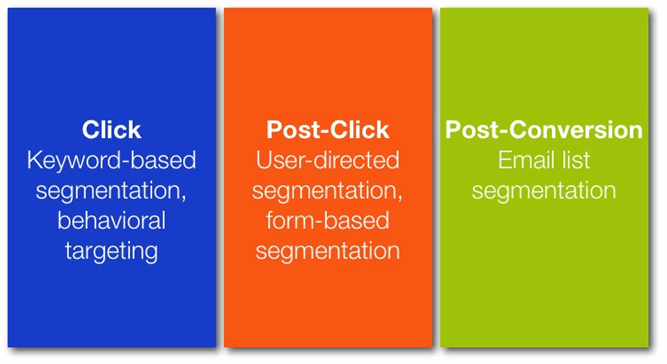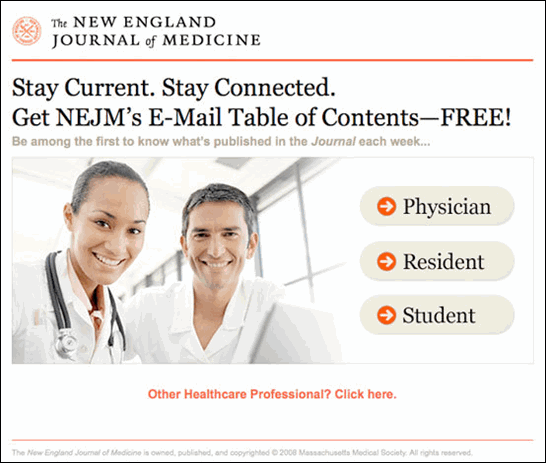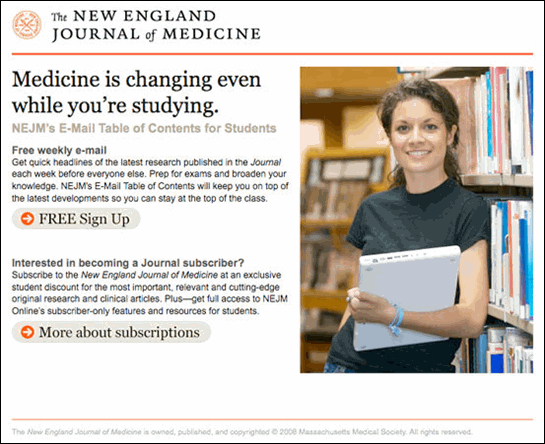There are many ways to segment your online visitors in the three phases of online marketing.
On the pre-click side, there is keyword-based segmentation, which maximizes the relevancy of your paid clicks. On the post-conversion side, there is email list segmentation, which as most marketers know, boosts email marketing performance.
And then, on the post-click side, there is form-based landing page segmentation, which can sometimes provide valuable data, after you sort through all the associate-level astronauts in Arizona who have a company revenue of over 1 billion. And there’s also user-directed, or post-click segmentation.
User-directed segmentation is a form of segmentation in which landing experience visitors are presented with a few simple choices to make about who they are and what they’re looking for, and the subsequent pages that the user lands on are more relevant and tailored to the visitor’s audience segment. The choices that the visitor makes are always in their self-interest and the user directs how they are segmented.
In the example below, visitors to this conversion path can segment as “physicians,” “residents,” or “students” (and “other healthcare professionals” in the bail-out link).
The subsequent pages of this conversion speak directly to the strategically chosen targets, yielding high conversions when the message gets more personal on the offer pages. Visitors who self identified as “physicians,” “residents” and “students” get more specific messaging on their offer pages.
Taking over where keyword segmentation leaves off, this kind of user-directed segmentation:
- Reveals valuable insights about your visitors: By analyzing what visitors are clicking on, you can measure what segments of your audience are (or AREN’T!) engaging with your landing experience, what segments are (or AREN’T) converting, and what sources of traffic are delivering your most qualified visitors.
- Improves the relevancy of your message and offer: The more specific your messaging gets, the more effective your overall search and PPC marketing.
- Increases conversions: Of course, by improving the relevancy of your campaigns and analyzing the segmentation choices people make, you’ll ultimately boost conversions.
- Improves lead quality: By segmenting your visitors and gaining insights into who is (and isn’t) clicking your ads, you can optimize your messages for your different sources of traffic and different audience segments, and ultimately improve your lead quality, as well.
There are many ways to segment your visitors with user-directed segmentation, including:
- The specific “problem” the visitor wants to solve
- The demographic/psychographic “persona” of the visitor
- The visitor’s stage in the buying process
- The role of the visitor in their organization
- The visitor’s geographic location
- The visitor’s industry or the size of their organization
- The visitor’s product preference
Landing pages that utilize user-directed segmentation can be many layers deep, with one initial segmentation page, and other sub-segmentation “beneath” the first page. It’s really up to you – the marketer – to decide what structure to test. And then it’s up to your visitors to decide which layout and structure yields the best, most qualified conversions.
You may be thinking, “Won’t making visitors click through pages make them abandon?” At ion, we’ve found the opposite to be true. The more specific and targeted your landing experience is, the better its performance. And by segmenting your visitors with split-second, simple choices, you’ll keep the visitor moving through the landing experience in the same rhythm that got them to click. But it’s always important to analyze your segmentation rate (the inverse of your bounce rate) and determine how many people continue to the second page of a landing experience. A good segmentation rate is above 60%.
User-directed segmentation is an extremely powerful way to improve your online marketing. By experimenting with different messages, segmentation choices, and organizational “structures,” you can make the right media buys, capture the right audience, convert the best leads with the right fulfillment, and optimize your entire online marketing chain, not just the individual components.
Megan Leap is Marketing Manager at ion interactive, a leading provider of advanced landing page software. As Marketing Manager, Megan manages search, email, webinar, and social media campaigns. She has extensive experience in conversion rate optimization and social media marketing, and when not championing high-ROI online marketing strategies, can be found running marathons across the U.S. She is also a frequent contributor to the Post-Click Marketing Blog. Follow Megan on Twitter: @MeganLeap.
(Read more: How to Create the Best Landing Pages for Your Google AdWords Account)







0 Comments